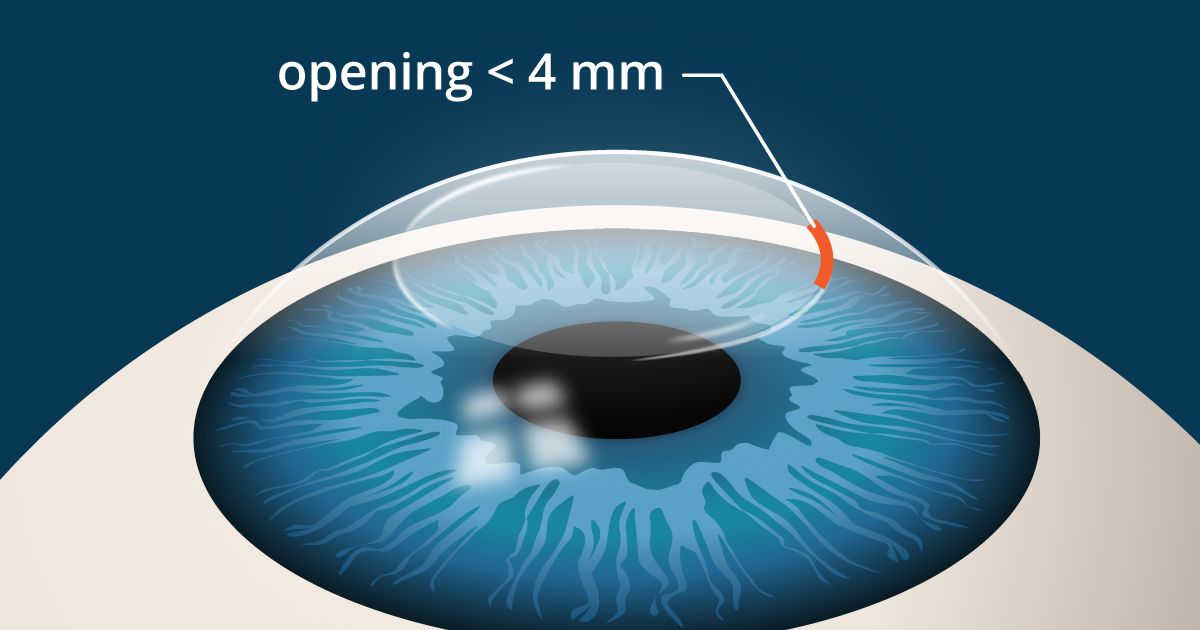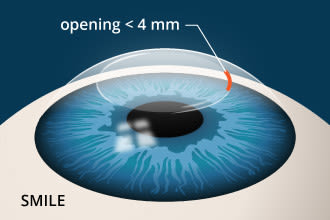SMILE eye surgery: Small Incision Lenticule Extraction

SMILE (small incision lenticule extraction) is a laser vision correction surgery that is similar to LASIK.
Here’s what you should know about this procedure if you are interested in laser surgery to correct nearsightedness.
The SMILE procedure
SMILE laser eye surgery is performed using a VisuMax femtosecond laser, which is proprietary technology of Carl Zeiss Meditec.

In LASIK, a large opening is required to enable the excimer laser to reshape the underlying cornea.

In SMILE, only a very small opening is needed (often less than 4 mm) to facilitate removal of the lenticule.
In the SMILE procedure, the surgeon uses a femtosecond laser to create a small, lens-shaped bit of tissue (lenticule) within the cornea.
Then, with the same laser, a small arc-shaped incision is made in the surface of the cornea, and the surgeon extracts the lenticule through this incision and discards it.
With the tiny lenticule removed, the shape of the cornea is altered, correcting nearsightedness. The corneal incision heals within a few days without stitches, and sharper vision occurs very quickly.
SMILE laser eye surgery can correct up to -10.00 diopters (D) of nearsightedness. Candidates must be at least 22 years old, have no more than -0.50 D of astigmatism, and their eyeglass prescription must be stable for at least 12 months.
SMILE benefits and advantages
Research has shown SMILE produces virtually the same visual acuity as LASIK for the correction of nearsightedness, without the need to create a LASIK-style corneal flap.
In one study of 328 people who underwent the SMILE procedure, all but one had uncorrected visual acuity (UCVA) of 20/40 or better after surgery, and 88 percent had UCVA of 20/20 or better.
Research suggests there may be less risk of dry eyes after SMILE, compared with after LASIK.
Also, it appears there may be less risk of dry eye symptoms after SMILE, compared with LASIK. There may be several reasons for this, including that because SMILE takes place within the cornea without a large corneal flap, fewer corneal nerves are affected by the procedure.
The very small SMILE incision may also enable the cornea to have more biomechanical stability after SMILE, compared with its ability to maintain shape (especially following trauma) after LASIK.
Finally, for correction of high amounts of nearsightedness, with LASIK there's a greater risk of needing an enhancement procedure to attain the clarity of vision desired without glasses. It appears there is less risk of needing an additional procedure after SMILE for correction of high amounts of myopia, possibly because less dehydration of the cornea occurs during the SMILE procedure.
Limitations of SMILE laser eye surgery
Are there any downsides to SMILE when compared with LASIK or PRK?
For starters, SMILE currently is used primarily to treat only nearsightedness, whereas LASIK and PRK routinely are used to correct nearsightedness, farsightedness and astigmatism.
(The treatment range for SMILE and other laser procedures varies in different parts of the world. Consult your eye doctor for details.)
Also, LASIK and PRK can treat higher-order aberrations (HOAs) that can affect night vision, whereas SMILE cannot. In fact, SMILE might increase HOAs to some degree.
And if you have residual refractive error after a SMILE procedure and require additional vision correction, typically PRK (not a second SMILE) is the preferred enhancement procedure for best results.
Finally, as with any newer vision correction surgery, it may be necessary for a surgeon to perform a significant number of SMILE procedures before he or she masters the surgical techniques required for optimum outcomes and minimal risks. Keep this in mind when considering SMILE (versus LASIK or other vision correction procedures).
Cost of SMILE surgery
The cost of SMILE is comparable to the cost of premium (custom) LASIK surgery.
Laser vision correction prices vary in different parts of the world. Consult your eye doctor for availability and cost of SMILE in your area.
Is SMILE right for you?
If you are nearsighted and meet the other criteria stated above, you might be a good candidate for SMILE laser vision correction. The next step is to have a comprehensive eye exam and a consultation with a refractive surgeon.
Page published on Friday, 22 March, 2019





